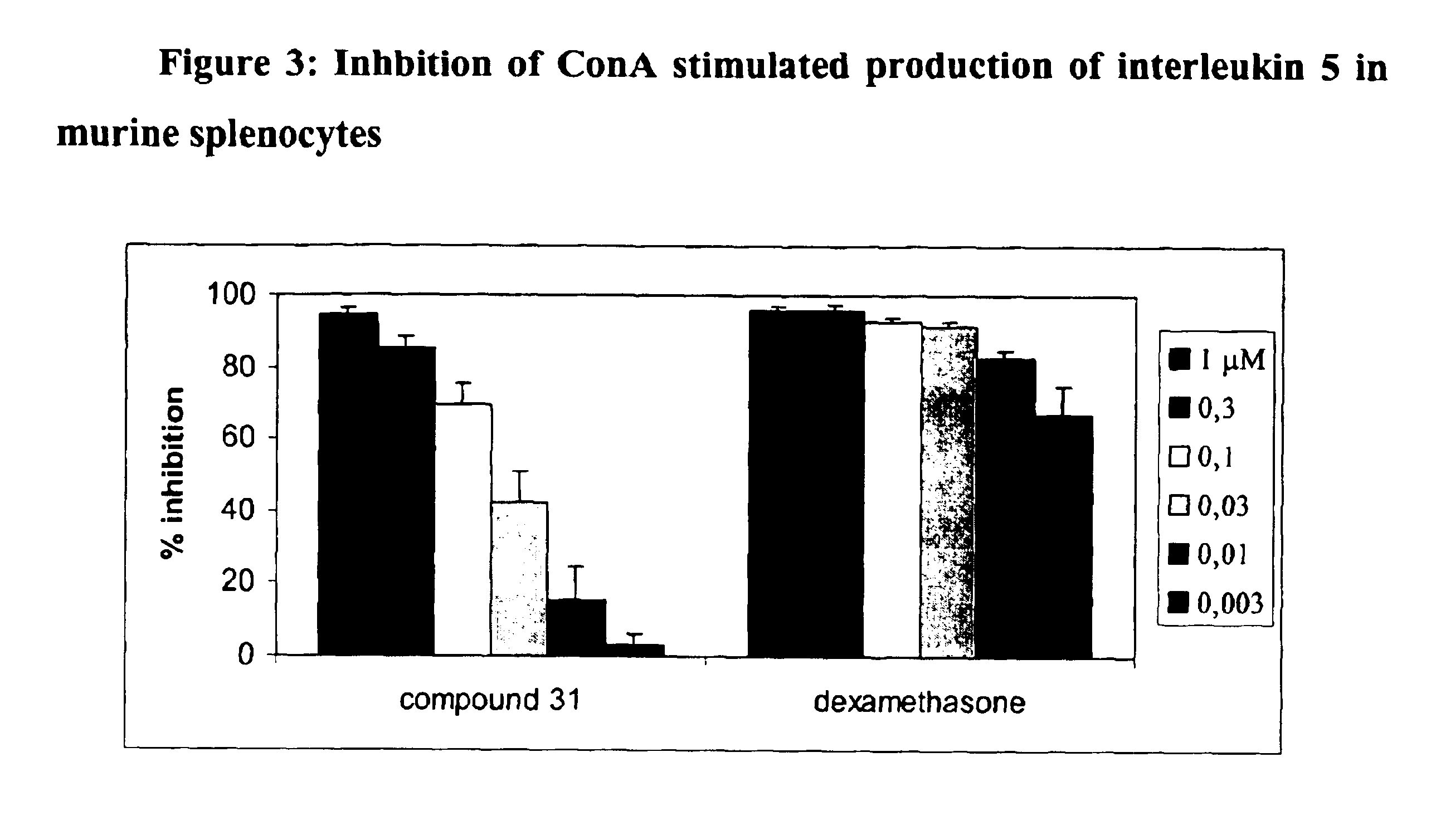Compounds, compositions and methods for treatment of inflammatory diseases and conditions
a technology of inflammatory diseases and compositions, applied in the field of compounds, compositions and methods for treating inflammatory diseases and conditions, can solve the problems of many unfavourable side effects, ideal steroid, and inability to achieve unfavourable effects in long-term and continuous treatment as required, and achieve weak inflammatory effects
- Summary
- Abstract
- Description
- Claims
- Application Information
AI Technical Summary
Benefits of technology
Problems solved by technology
Method used
Image
Examples
example 1
[0263]Compound 1: I; M=M1, L=L1, S=S1; (R2=R3=R4=H, X1=—CH2—; m=2, X2=—NH—, Ra=F, Rb=H, Rd=OH)
[0264]In 5 mL of dry dichlormethane, 76 mg of the steroid S1 (0.2 mmole) was dissolved in an inert atmosphere. Subsequently, 0.25 mL of triethylamine, 53 mg of hydroxybenzotriazole, 150 mg of the macrolide A3 (0.2 mmole) and 157 mg of 1-(3-dimethylaminopropyl)-3-ethylcarbodiimide hydrochloride was added to the solution. The reaction mixture was stirred at room temperature overnight. The solvent was evaporated under reduced pressure. The mixture obtained was purified on a silica gel column, eluent CHCl3:MeOH:NH4OH=6:1:0.1. 167 mg of the compound 1 was obtained; MS (m / z): 1109.7 [MH]+. IR(cm−1) / KBr: 3425, 2974, 2939, 2875, 1721, 1665, 1627, 1525, 1459, 1379, 1296, 1262, 1168, 1125, 1064, 1035, 1013, 959, 927, 894, 804.
example 2
[0265]Compound 2: I, M=M1, L=L1, S=S2; (R2=R3=R4=H, X1=—CH2—, m=2, X2=—NH—, Ra=Rb=F, Rd=OH)
[0266]In 5 mL of dry dichlormethane, 80 mg of the steroid S2 (0.2 mmole) was dissolved in an inert atmosphere. Subsequently, 0.25 mL of triethylamine, 53 mg of hydroxybenzotriazole, 150 mg of the macrolide A3 (0.2 mmole) and 157 mg of 1-(3-dimethylaminopropyl)-3-ethylcarbodiimide hydrochloride was added to the solution. The reaction mixture was stirred at room temperature overnight. The solvent was evaporated under reduced pressure and the mixture obtained was purified on a silica gel column, eluent CHCl3:MeOH:NH4OH=6:1:0.1. 129 mg of the compound 2 was obtained; MS (m / z): 1127.7 [MH]+. IR(cm−1) / KBr: 3424, 2972, 2939, 2876, 1719, 1670, 1631, 1560, 1523, 1458, 1379, 1317, 1264, 1167, 1127, 1064, 1033, 997, 960, 900, 820, 735, 709.
example 3
[0267]Compound 3: I; M=M1, L=L1, S=S3; (R2=R3=R4=H, X1=—CH2—, m=2, X2=—NH—, Ra=Cl, Rb=F, Rd=OH)
[0268]80 mg of the steroid S3 (0.19 mmole) was dissolved in 5 mL of dry dichlormethane in an inert atmosphere. 0.25 mL of triethylamine, was added to the solution, which became clear. Subsequently, 53.5 mg of hydroxybenzotriazole, 145 mg of the macrolide A3 (0.19 mmole) and 157 mg of 1-(3-dimethylaminopropyl)-3-ethylcarbodiimide hydrochloride were added. The reaction mixture was stirred at room temperature overnight. The solvent was evaporated under reduced pressure and the obtained mixture was purified on a silica gel column, eluent CHCl3:MeOH:NH4OH=6:1:0.1. 200 mg of the compound 3 was obtained; MS (m / z): 1143.6 [MH]+. IR(cm−1) / KBr: 3423, 2971, 2937, 2876, 1719, 1668, 1630, 1561, 1523, 1459, 1379, 1319, 1262, 1168, 1125, 1064, 998, 959, 901, 819, 756.
PUM
| Property | Measurement | Unit |
|---|---|---|
| Immunogenicity | aaaaa | aaaaa |
| Valence | aaaaa | aaaaa |
Abstract
Description
Claims
Application Information
 Login to View More
Login to View More - R&D
- Intellectual Property
- Life Sciences
- Materials
- Tech Scout
- Unparalleled Data Quality
- Higher Quality Content
- 60% Fewer Hallucinations
Browse by: Latest US Patents, China's latest patents, Technical Efficacy Thesaurus, Application Domain, Technology Topic, Popular Technical Reports.
© 2025 PatSnap. All rights reserved.Legal|Privacy policy|Modern Slavery Act Transparency Statement|Sitemap|About US| Contact US: help@patsnap.com



